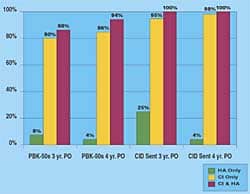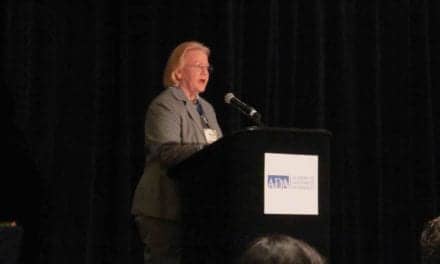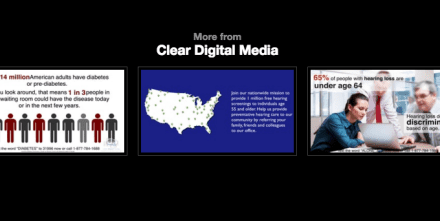A recent survey by the American Academy of Audiology indicated that 63% of people with hearing loss listed their primary care physician as their most important source of information about where to go for hearing health care services. A physicians “Lunch & Learn” program, as detailed here, can open doors and generate new physician referrals while helping inform busy medical personnel about the importance of screening patients for hearing loss. A presentation on hearing health care and a demonstration on the use of hand-held screeners can significantly increase referrals to a hearing care office.
In the past four years, there have been numerous articles and workshops focusing on the need to market audiology services to primary care physicians.1 The results of a marketing study by the American Academy of Audiology indicated that 63% of people with hearing loss listed primary care physicians as their most important source of information about where to go for hearing health care services.2 The recommended techniques to market to physicians have been personal visits, follow up reports, promoting a hearing screening instrument and regular mailing of newsletters written specifically for physicians.3
Our office in the San Francisco Bay area has used many of the marketing options listed above, and all have shown at least some measure of success. In 2000, our practice decided to take the process a step further by holding physician seminars in our local area. We call it a “Lunch and Learn” program.
All the physicians in our area (not just general practitioners, ENTs and internists) are invited to attend. Why? Many types of physicians deal regularly with hearing-impaired patients. Therefore, the program is inclusive, not exclusive. All physicians know someone (patients, colleagues, family, etc.) who has a hearing loss. They may not deal with them very often, but they can become a referral source no matter how small. If you spend $20 to have them attend, you certainly only need one referral to more than pay for the cost.
We should not be myopic in educating professionals about hearing loss and hearing instruments. In the future, our office will also include the following professionals in our Lunch & Learn program: physical therapists, psychologists, attorneys, CPAs, financial advisors who specialize in trusts and probate work, and nursing staff from elder home care facilities. We are seeking to influence any profession involved with the senior population.
Lunch & Learn Overview
Those invited to attend are sent a letter 4-6 weeks in advance of the luncheon to give them plenty of notice. In the letter, we include the schedule, which we keep very tight. We have found that attending to a strict schedule is beneficial:
| 12:15: | Introductions and overview. |
| 12:15-12:35: | Presentation on hearing loss and amplification. |
| 12:35: | Questions are fielded. |
| 12:35-12:50: | Showing of hand-held screeners and ALDs. |
| 12:50-1:00: | Finish presentation and answer specific individual questions. |
The attendees leave to get back to their patients from 1:00-1:15. We find that several will stick around for 15-30 minutes afterwards and ask questions or just discuss their own practice, etc. (i.e. schmooze). This is an excellent place for long-term working relationships to develop.
A follow-up notice is sent via fax 2-3 weeks before the luncheon to the physicians who have not yet responded. The fax will have a box to check:
- Will attend;
- Cannot personally attend but a nurse or nursing staff will;
- Would like to receive your physician newsletter;
- Would like information packet from seminar, or
- Not interested.
Inviting the nursing staff to attend is also beneficial since they may be doing the screening or handing out our business card to the patient.
Any marketing tactic which increases physician and nurse attendance should be used. We believe that offering the opportunity for physicians to come and learn is actually the most important aspect of the Lunch & Learn program. Physicians want information on hearing loss, as the AAA study and Dennis Hampton’s Physician HealthCare Newsletter prove.2,3
It should be acknowledged that your “hit rate” for these types of seminars may be small—only 4-8 physicians at your first luncheon. Do not focus on the numbers alone to predict the success of the luncheon. Remember, it takes only one physician referring 2-5 times a month to make a noticeable difference in a practice.
As time goes on, your luncheon will become a routine that will give you a chance to get to know your local physicians personally. You become the expert—someone they trust—and they feel comfortable referring their patients to your practice.
The Presentation
The presentation can be made by you on many different topics regarding hearing conservation, hearing loss, tinnitus retraining therapy, digital technology, etc. Obviously, you will want to concentrate on aspects that are related to your practice’s services.
Inviting sales representatives to give presentations is also an excellent option. For example, a number of our seminars have featured Laurel Hinton, a representative from Siemens Hearing Instruments (and now with Sonic Innovations). Siemens is a well-known name in the medical field, and we felt physicians might be more comfortable with that name recognition. However, we are confident that most manufacturer representatives would be happy to make a presentation and that those presentations would be equally effective. Access to presentation materials and AV equipment are another practical advantage that sales representatives have in making a great presentation to doctors. It is extremely important to have a presenter who is personable, dynamic, funny, and most importantly, knowledgeable. (Laurel, for example, was a practicing audiologist before she became an industry representative. Therefore, her answers to questions regarding technology and audiology are very straightforward and clear.)
Our luncheons are free to attendees and take place at high-end restaurants where a separate room is available. Entrees are in the $9-18 price range for lunch and the $18-35 range for dinner. The objective is to have a nice place with excellent service. This is not the place to be frugal with your marketing dollars. You want those attending to have a very positive experience and to be impressed by you. If they gain knowledge, but have a mediocre meal, that reflects on you as much as the restaurant.
As the physicians and nurses are arriving, we have information for them to look over while bread and salads are served. They eat their main course during the presentations, and dessert during the questions so as to keep the mealtime efficient. This is a great way for them to digest food and information at the same time.
Like any health care professional, doctors and nurses are busy people who often have tight schedules. We make it known that attendees are free to leave when necessary to avoid being late back to the office. In the future, we are going to try a dinner seminar to eliminate time constraints posed by having the luncheon during business hours.
Demonstration Screeners
It is important to show and fully demonstrate the use of portable hand-held screeners that can be used by physicians. Our favorite hand-held screener is a Welch Allyn screening otoscope that tests hearing at 20, 25, and 40dB at 500, 1K, 2K, and 4K. (Author’s Note: There are several options for hearing screeners and we encourage HR readers to check into them.) The cost of this device is approximately $600-625. While this may seem expensive, if you can get a physician to try and regularly use this in his/her office, the screener pays for itself.
At our first luncheon, we had an internist who mentioned that the screener was something he could use in his office because it was small, simple to use and easy to handle. He had referred patients to our office sporadically in the past. It was just before the holidays, so around Christmastime, we dropped off a screener at his office to have him try for 30-60 days. We told him if he didn’t use it to let us know and we would come back and get it. Since that time, he has referred to our office an average of 2-3 patients per month—and all of the patients have had significant hearing loss and nearly all have purchased amplification devices from us. The initial investment of $625 now seems rather small. This is not to advocate simply mailing these devices indiscriminantly to physicians; physicians receiving the devices need to recognize the need for hearing health and hearing screenings.
A Simple Program that Works
The Lunch & Learn program works well and we strongly encourage hearing care professionals to give this concept a try. We send letters to all our patients’ primary care physicians when the patient is first seen in the office. Every quarter, we send these physicians Audiology HealthCare News, which has proven to be an excellent resource for them.3 We also conduct a physician’s seminar once a year.
While the industry as a whole has been flat or decreasing during the past two years, our business has been increasing. Our marketing efforts toward physicians is one of the reasons for our success as a growing practice.
Although we’re aware and applaud other physician marketing programs (BHI, AAA, ADA, etc.), we feel the real answer for private practice professionals is to do the marketing yourself. Don’t wait for an organization to help you out (especially if you are not in a large metropolitan area). Be proactive and get to know the physicians in your area on your terms. It is definitely worth the effort.


|
The authors invite HR readers to contact them with any questions or comments regarding the Lunch & Learn program. Correspondence can be addressed to HR or Mark J. Sanford, MS, CSG/Better Hearing Center, 31 Panoromic Way, 1st Floor, Walnut Creek, CA 94595; website: www.betterhearing.com.
References
1. Whichard S: Gaining referral through a physician marketing program. Hearing Review 1998; 5(11): 12-16.
2. American Academy of Audiology: 1997 Marketing Study. Audiology Today 1998; 10(1):10-15.
3. Hase M: Is marketing to physicians worthwhile? Results of a survey. Hearing Review 2000; 7(4): 43.





